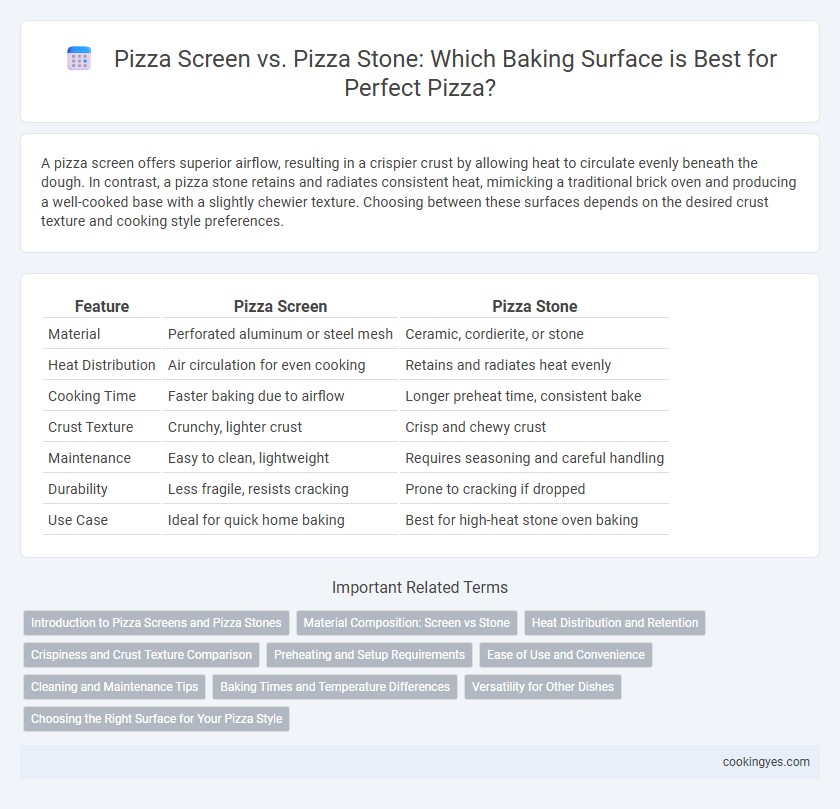A pizza screen offers superior airflow, resulting in a crispier crust by allowing heat to circulate evenly beneath the dough. In contrast, a pizza stone retains and radiates consistent heat, mimicking a traditional brick oven and producing a well-cooked base with a slightly chewier texture. Choosing between these surfaces depends on the desired crust texture and cooking style preferences.
Table of Comparison
| Feature | Pizza Screen | Pizza Stone |
|---|---|---|
| Material | Perforated aluminum or steel mesh | Ceramic, cordierite, or stone |
| Heat Distribution | Air circulation for even cooking | Retains and radiates heat evenly |
| Cooking Time | Faster baking due to airflow | Longer preheat time, consistent bake |
| Crust Texture | Crunchy, lighter crust | Crisp and chewy crust |
| Maintenance | Easy to clean, lightweight | Requires seasoning and careful handling |
| Durability | Less fragile, resists cracking | Prone to cracking if dropped |
| Use Case | Ideal for quick home baking | Best for high-heat stone oven baking |
Introduction to Pizza Screens and Pizza Stones
Pizza screens and pizza stones both enhance crust quality by improving heat distribution during baking. Pizza stones, typically made from ceramic or cordierite, retain and evenly radiate heat, producing a crisp, well-cooked base. Pizza screens, usually made of aluminum mesh, promote airflow beneath the dough to prevent sogginess and speed up baking time, making them ideal for thinner crust pizzas.
Material Composition: Screen vs Stone
Pizza screens are typically made from lightweight aluminum mesh, which promotes airflow and helps produce a crispier crust by allowing moisture to escape during baking. Pizza stones are composed of dense materials like cordierite or ceramic, designed to evenly retain and distribute heat for a uniform bake and a chewy, well-cooked crust. The choice between aluminum screen and stone depends on desired crust texture and heat retention properties during the baking process.
Heat Distribution and Retention
Pizza stones offer excellent heat retention due to their dense ceramic or cordierite composition, ensuring a uniformly crispy crust by evenly distributing heat across the baking surface. In contrast, pizza screens, typically made from aluminum mesh, provide superior heat circulation beneath the dough, promoting a lighter, less crispy texture but allowing faster cooking times. Choosing between a pizza stone and screen depends on whether sustained heat retention or enhanced airflow for quicker baking is prioritized.
Crispiness and Crust Texture Comparison
Pizza screens promote superior airflow beneath the dough, resulting in a crisper crust with less moisture retention compared to pizza stones. Pizza stones, made from ceramic or cordierite, absorb and evenly distribute heat to create a chewy, well-caramelized crust texture but tend to retain more moisture. For achieving maximum crispiness and a lighter crust, pizza screens outperform pizza stones in preventing sogginess during baking.
Preheating and Setup Requirements
Pizza screens heat up faster due to their open mesh design that allows hot air to circulate directly under the crust, reducing preheating time compared to dense pizza stones. Pizza stones require longer preheating, typically 30-45 minutes at high temperatures, to reach optimal thermal mass for even heat distribution. Screens demand minimal setup, often heated alongside the oven, while stones need placement on the oven rack before preheating to avoid thermal shock and cracking.
Ease of Use and Convenience
Pizza screens offer superior ease of use and convenience due to their lightweight, perforated design that allows quick heat transfer and easy handling without preheating. Pizza stones require longer preheating and careful handling because of their heavy, fragile nature, making them less practical for frequent use. The perforations in pizza screens prevent sogginess by promoting airflow, simplifying clean-up compared to the porous surface of pizza stones.
Cleaning and Maintenance Tips
Pizza screens offer easier cleaning compared to pizza stones, as their perforated aluminum or steel surface resists dough residue buildup and can be washed with warm soapy water or placed in the dishwasher. Pizza stones absorb oils and moisture, making thorough cleaning challenging since they should never be soaked or scrubbed harshly to prevent cracking or damage. To maintain a pizza stone, simply scrape off food debris with a stiff brush, wipe with a damp cloth, and allow it to air dry completely before storage.
Baking Times and Temperature Differences
Pizza screens allow for faster baking times by promoting better airflow and heat circulation, typically baking pizzas between 450degF to 500degF in 7-10 minutes. Pizza stones retain and distribute heat evenly, resulting in a slightly longer baking time of 10-15 minutes at higher temperatures around 500degF to 550degF. The stone's thermal mass creates a consistent cooking surface that crisps the crust deeply, whereas the screen offers a lighter, airier crust with quicker cook times.
Versatility for Other Dishes
Pizza screens offer superior versatility as they allow air to circulate beneath the dough, making them ideal for baking not only pizzas but also flatbreads, crackers, and even roasting vegetables. Pizza stones retain heat evenly, providing excellent results for pizza crusts and artisan breads, but their solid surface limits airflow and is less suitable for thinner or more delicate baked goods. Choosing between a pizza screen and stone depends on whether you prioritize a range of cooking applications or consistent, heat-retentive baking performance.
Choosing the Right Surface for Your Pizza Style
Pizza screens offer a lightweight, breathable surface that promotes a crisp crust, ideal for thin and Neapolitan-style pizzas, while pizza stones retain and evenly distribute heat for a chewier, thicker crust favored in New York-style or deep-dish pizzas. Choosing the right baking surface depends on your preferred crust texture and pizza style; pizza screens excel at preventing sogginess by allowing moisture to escape, whereas pizza stones provide consistent heat for thorough cooking and a golden, crisp bottom. Optimal pizza baking involves matching the screen's airflow advantages with fast-cooking styles or leveraging the stone's heat retention for slow, even baking.
Pizza Screen vs Pizza Stone for Baking Surface Infographic

 cookingyes.com
cookingyes.com